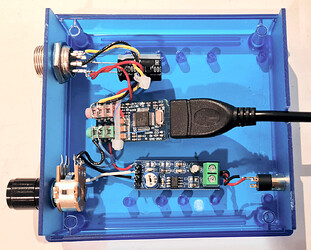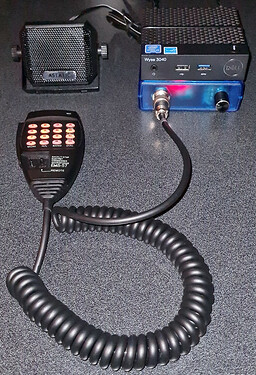Hi Mike, thanks for the comments. Some clarifications,
As mentioned in my How-To Guides (the one for the Radio-less node will be done in a few days and on my site AllScan.Info), I completely agree with your sentiments on the #1 best way to fix audio, in fact here is an excerpt from my Guide now in progress expanding on this point:
Audio Requirements
A radioless node should have equal or better overall audio performance and features as even the best radio-based nodes. There are really only 2 fundamental differences between radioless nodes and conventional (with radio) nodes, the first of course that one supports wireless analog FM, and the other that a node using radio(s) will have some differences in how the mic audio is processed. FM radios provide well-controlled audio filtering and limiting to ensure that the transmitted RF is not overmodulated, resulting in improved consistency of audio levels and improved intelligibility.
ASL filters Rx audio prior to encoding it and sending it to other connected nodes, and some small amount of compression/limiting/noise reduction may be done in the process of coding the audio in various supported VOIP codecs. Radios additionally do peak limiting of the mic signal to prevent transmitter overdeviation, which also maximizes average Signal-To-Noise Ratio (SNR) and better utilizes the available dynamic range of typical RF communications channels (which can be fairly low in weak signal conditions).
In nearly all pro audio, recording and broadcast applications some processing is done on voice signals which can include filtering out low and high frequency noise, clicks, pops, and sibilance; compressing the signal to give higher and more consistent average power levels; and limiting to prevent overly loud peaks and distortion. Numerous other techniques can also be used to further optimize clarity for a specific voice and application but those are not as applicable to a general node design.
It is important on AllStar and other digital/VOIP-linked communication networks to have consistent audio levels and dynamics from node to node. Otherwise users have to make frequent volume adjustments if one ham has very quiet audio or another has overly loud audio. This is an issue on AllStar and I highly recommend that any time you hear someone on AllStar who is much quieter or louder than average – let them know! Audio levels are very easy to adjust on AllStar and there is no good reason anyone should have improper levels that require everyone else to frequently adjust their volume controls to properly hear everyone in a QSO or net.
Building a radio-less node is pretty simple if you are experienced with computers, Linux, and AllStar. I hope that this Guide will help make the process easier for everyone, while sharing a few optimizations that can result in a node that sounds as good or better than any other node (with or without radios), with excellent audio quality and basic dynamics processing to provide full, clear sound typical of high-quality FM repeaters.
If you have a background in audio/music/recording/broadcasting you could easily achieve the above by running a good quality mic into a mixing console or mic preamp & dynamics processor, then run the output into any radioless node, which would be a good way to get great audio. A simpler approach however is to add a small audio preamp and dynamics processing module to the node, at which point a standard handheld DTMF mic can be used with no extra boxes or cables needed.
Some small amount of gain with fast limiting helps smooth out the raw mic audio coming from a DTMF hand mic and improve average signal levels. A slight amount of compression (e.g. a 2:1 ratio above a threshold of -10dBFS) along with hard limiting of the signal to 0dB FS, ensuring no clipping of the CM108AH ADC should give the resulting signal a similar sound to radio-based nodes.
An article on Repeater-Builder.com talks about this in more detail, proposing an Auto-Gain Control (AGC) controlled by a side-chain signal low-passed between 800~1500 Hz to provide smooth subtle leveling while not significantly affecting the higher frequency content and intelligibility. This should be useful not only for radioless nodes but for any node. Some additional slight compression can then be done to increase average signal energy and SNR, and then the signal should be hard limited to prevent clipping the node’s ADC.
The microphone is the first step in the signal chain of any node and if the audio levels and dynamics of the mic are bad, there may not be a lot that a basic dynamics processing module can do to help. The audio may still be thin sounding with poor frequency and phase response and little if any resistance to clicks and plosives. In having tested many studio mics, desk mics, and hand mics over many years, I have never once seen a hand mic that sounds anywhere near as good as a high quality desk mic (such as the Icom SM-10, SM-50, or Kenwood MC-85).
AllStar nodes should always support the use of a DTMF keypad for control functions which implies that a radioless node needs to either use a DTMF mic or integrate a DTMF keypad into the node itself. Getting a mic that already has a DTMF keypad is the simpler option but this greatly limits the mic options to those that have a keypad and output actual DTMF audio rather than serial port button press data. Thus with this node an Alinco EMS-57 is recommended as it seems to be the only widely available mic that meets these requirements, and works with a 5V input allowing it to be easily powered from a 5V USB power source. This is a cheap hand mic however and thus without additional processing the node’s receive audio may not sound particularly great. It might sound fine compared to an average node used with an HT, since HT mics are just as bad as hand mics, but HTs do provide additional flexibility in that any mic can be plugged into the mic jack while the HT front panel still provides a DTMF keypad.
Ideally you could use a high quality desk mic with a built-in preamp and adjustable compressor, and integrate a DTMF keypad into either the mic or the node itself, but that would take some effort and might not be cheap. For those who know the value of good quality audio, this is worth doing, and you probably already have a good mic you use with your HF radios that could be shared with a radioless node using a simple mic switch (eg. an MFJ-1263).

